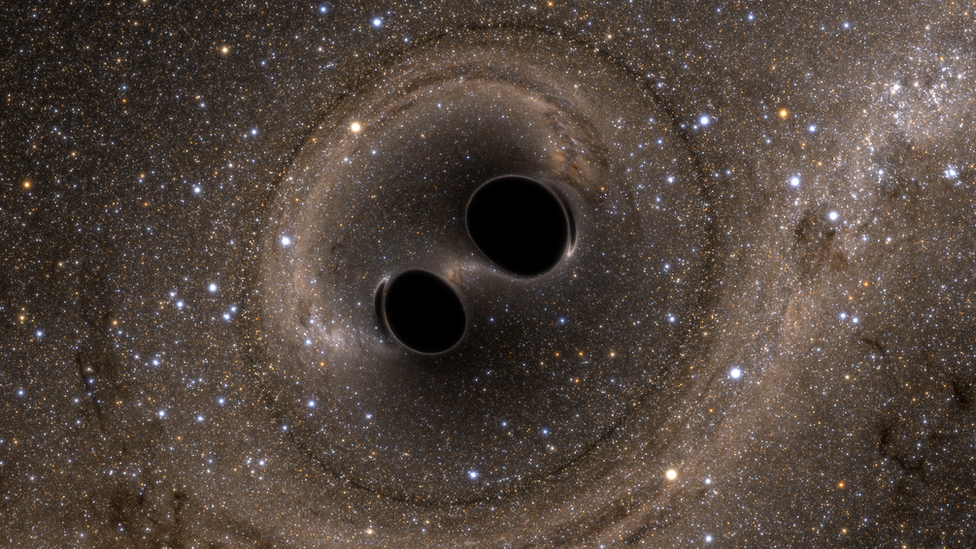Gravitational waves hunt now in overdrive
- Published
Mansi Kasliwal & Samaya Nissanke: "From discovery to making precision measurements"
Scientists working to detect gravitational waves switched on their instruments for a third time at the beginning of April and immediately began to register events that could be interpreted as cosmic collisions. All five trigger events still need confirmation. The BBC's Roland Pease examines how telescopes worldwide are helping.
The alert on Mansi Kasliwal's phone went off at two in the morning. Shrugging off the sleep, she squinted at the message. It was from LIGO, the Nobel Prize-winning scientific collaboration that operates gravitational wave detectors.
A far-off violent event had sent ripples in space-time through the Universe, to be picked up by LIGO's sensor in Louisiana, and it looked from the data like there should be visible "fireworks", too.
Thanks to the smartphone revolution, she could react without leaving her bed. A few taps on the screen, and the Zwicky Transient Facility, a robotic telescope on Mount Palomar, was reprogrammed to start the hunt.
LIGO, the Laser Interferometer Gravitational-Wave Observatory, external, and its European counterpart, VIRGO, have just completed upgrades that mean they should be spotting space-distorting events several times each week - collisions of black holes, of neutron stars, and even more exotic phenomena.
And since they started running again at the start of April, expectations are holding up: two in the second week; three last week.
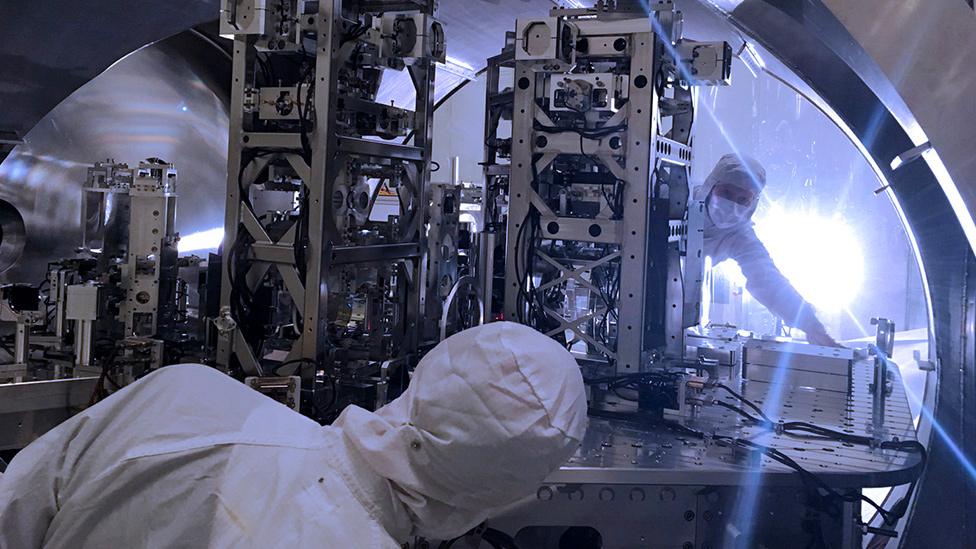
The detectors have just gone through an upgrade to increase their sensitivity
The first three, still to be formally confirmed, were probably collisions between black holes, like the first, Nobel-anointed event detected in 2015.
It was the next, on 25 April, that woke Mansi Kasliwal up. The gravitational ripples hinted at the involvement of neutron stars, which would be engulfed in a scorching nuclear flame as they devoured each other and became one.
The radio, optical, X-ray and gamma-ray colours would reveal new details about these normally secretive objects. But before the specialist telescopes could zoom in on the action, astronomers needed to know exactly where to look.
That is where the Zwicky Transient Facility (ZTF), external comes in, a new instrument able to scan large swathes of the sky swiftly for anything new and unusual.
The 25 April "candidate" event was going to test that capacity. With LIGO's second detector temporarily out of action (the one in Hanford, Washington State), LIGO and VIRGO could only narrow the search to a quarter of the entire sky: somewhere in that vast darkness, a new spark could be brightly shining, but beginning to fade.

Gravitational waves - Ripples in the fabric of space-time

The LIGO Louisiana lab has 4km-long pipes running out from its control centre
Gravitational waves are a prediction of the General Theory of Relativity
It took decades to develop the technology to directly detect them
They are ripples in the fabric of space-time generated by violent events
Accelerating masses will produce waves that propagate at the speed of light
Detectable sources include merging black holes and neutron stars
LIGO/VIRGO fire lasers into long, L-shaped tunnels; the waves disturb the light
Detecting the waves opens up the Universe to completely new investigations

ZTF has the ability to photograph an area about 14 Moons by 14 Moons in just 30 seconds, and see anything down to 150,000 times dimmer than the faintest star visible to the human eye. In a little over two hours it has scoured this whole target area, before moving on to a new sector.
Meanwhile, astronomers across the planet were dialling into teleconferences. Which are the best telescopes to make the detailed observations? Where is it daylight, and where were the skies dark?
ZTF was so effective, it detected several hundred thousand bright points in the sky that had not been there the night before. "The Universe is an extremely dynamic place; it's not the same every time you look at it," Mansi Kasliwal told the BBC's Science in Action programme on the World Service.
"In fact, every second a supernova goes off somewhere in the Universe."
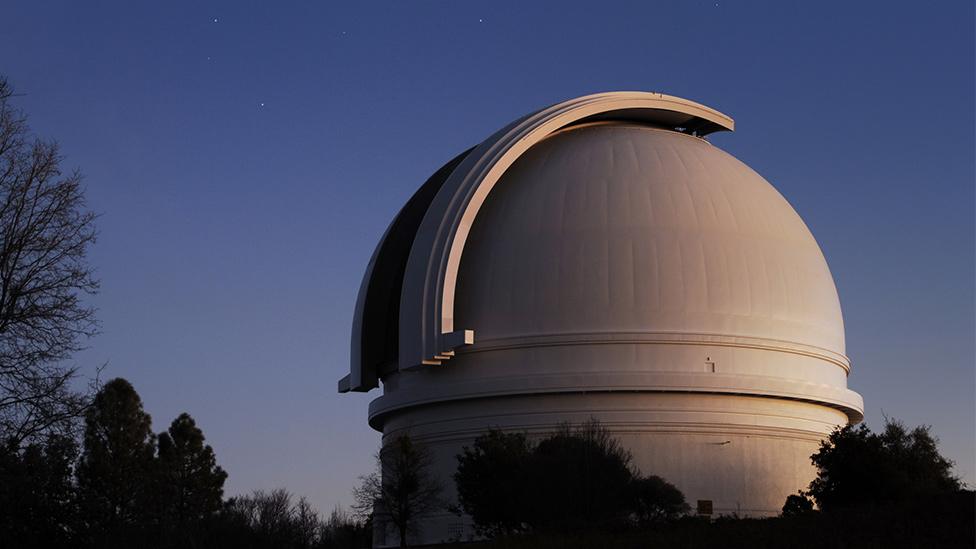
The Zwicky Transient Facility is based at the Palomar Observatory
On top of that, there are stellar flares, galactic flashes, and comets or asteroids hoving into view, plus stars that had shifted position almost imperceptibly since the last viewing.
Machine learning algorithms whittled that fog of activity down to just two candidates whose coordinates were shared with 2,000 other astronomers to scrutinise more closely.
It was while Mansi awaited their reports that the system kicked into action for the second time in 30 hours.
Another alert from LIGO, again involving neutron stars, though in this case possibly a single neutron star being swallowed by a black hole.
"My team just froze; we were stunned by this - we hadn't slept, but also we didn't know if such a thing could exist," she recalls.
This time, all three gravitational wave detectors were operational, tightening the location, but the signal was weaker and more ambiguous, perhaps not even genuine.
Nevertheless, a second search had to be started.
It was morning in California, so the Zwicky telescope was no use. But Mansi Kasliwal could call on the services of telescopes in the international network she directs - GROWTH (for Global Relay of Observatories Watching Transients Happen), external. The hunt was on again, from Hawaii, Chile and India.
"This would be the discovery we have all been waiting for in the new phase of the LIGO-VIRGO collaboration," says astrophysicist Samaya Nissanke of Amsterdam University in the Netherlands and a member of the VIRGO team.
The initial analysis gave just a 13% chance the waves were stirred up by a neutron star diving into a black hole, but also a 14% chance it was just a glitch down here on Earth. And even if it was real, a really massive black hole would swallow the dead star so thoroughly it would leave no visible trace.
"There is this sweet spot, though, where we expect there will be some matter disrupted just as it gets swallowed by the black hole," Samaya Nissanke told the BBC. "And it is this matter that would generate the electromagnetic signals we might see."
Allow X content?
This article contains content provided by X. We ask for your permission before anything is loaded, as they may be using cookies and other technologies. You may want to read X’s cookie policy, external and privacy policy, external before accepting. To view this content choose ‘accept and continue’.

April was an amazing month for black hole science, with the first image of a black hole also being released

Time is of the essence.
Gamma-rays and X-rays seen from satellites would fade in hours as the nuclear flame cools; the optical signal might last days; and the radio glow could go on for weeks.
But while astronomers on other projects are happy, to an extent, to surrender their valuable telescope time to others observing these "targets of opportunity", they want to know it will be used well. Hence, the need for rapid follow-up scans to pinpoint plausible targets.
When LIGO and VIRGO found their first "kilonova" due to a pair of neutron stars in 2017, all the cards fell in place: the location was precise, the signal strong, and dozens of telescopes captured events across the spectrum and over weeks to give an unprecedented view of the violent Universe.
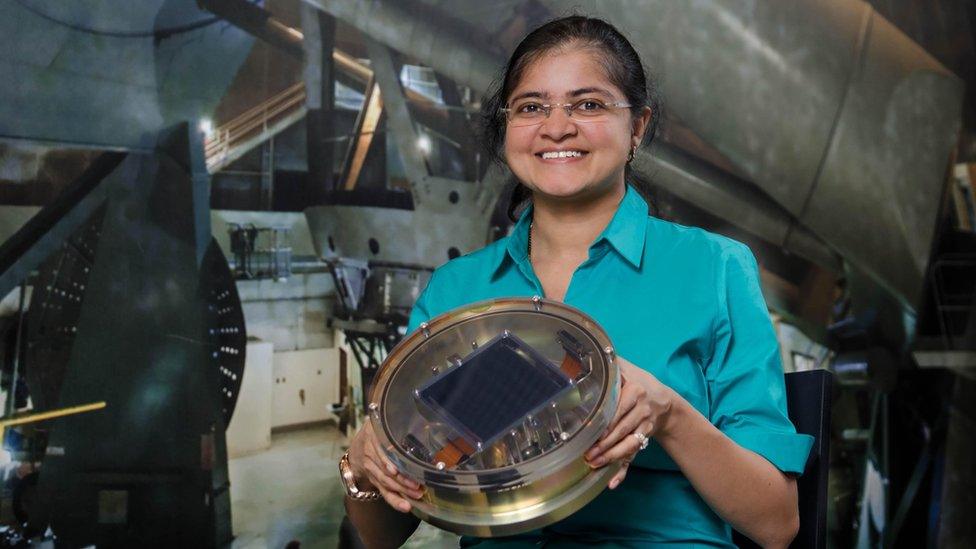
Mansi Kasliwal holding one of the ZTF detectors that maps the sky in rapid fashion
This past fortnight, astronomers have had a cold dose of reality. The two targets they found on the sky that might have been associated with the 25 April event turned out to be ordinary supernovae, dying stars, which could have been thrilling two decades ago, but are routine in modern observations. And that leaves astronomers in the dark as to what happened to set the gravity detectors off.
As for the second event - bad weather has hampered follow-up observations.
According to Mansi Kasliwal, there is one tantalising candidate that remains to be examined. But time is running out.
The astronomers are not disheartened, however.
"It was a let-down in terms of the final result," says Mansi Kasliwal of the first search. "But it is really a celebration in terms of the technological feat that we scanned a quarter of the sky and could pick out some candidates in just a few hours."
Samaya Nissanke agrees - it was a dress rehearsal that shows how quickly star-gazers can respond when gravitational waves pass by.
"It's just the reality that we really are seeing around a candidate trigger per week, which could include a few neutron star mergers this year," she says.
"We've stepped into an entirely new realm thanks to the hard work of observers like Mansi."
- Published17 October 2017
- Published16 October 2017
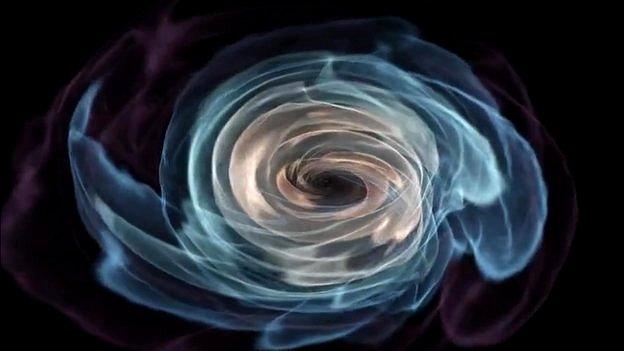
- Published3 October 2017
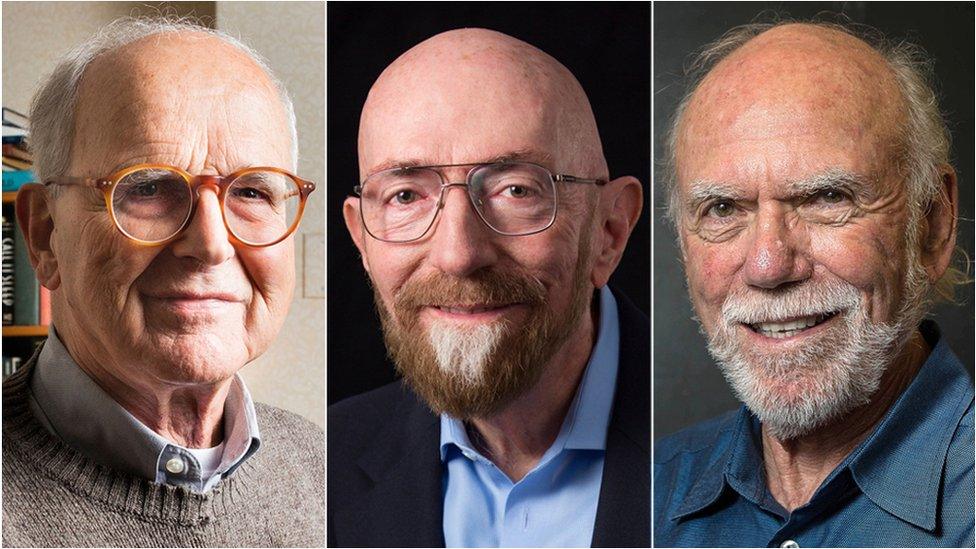
- Published20 June 2017

- Published12 February 2016
- Published11 February 2016
